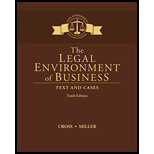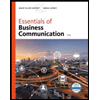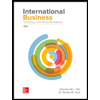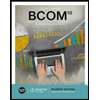
The Legal Environment of Business: Text and Cases (MindTap Course List)
10th Edition
ISBN: 9781305967304
Author: Frank B. Cross, Roger LeRoy Miller
Publisher: Cengage Learning
expand_more
expand_more
format_list_bulleted
Question
Chapter 11, Problem 7BCP
Summary Introduction
Case summary: The survivors of the Holocaust and the heirs of the Holocaust victims filed a case in the federal district court in the U.S. against various Hungarian entities alleging that they have expropriated property from the Hungarian Jews. The plaintiffs did not try to seek remedies from the Hungarian court nor they provided a legally compelling reason for not doing so. The defendants then asked the court to dismiss the court.
To find: in the case that the request of the defendant is supported by the principle of comity.
Expert Solution & Answer
Trending nowThis is a popular solution!

Students have asked these similar questions
BUSINESS LAW
3 - David Ungar holds a Dunkin’ Donut's franchise. The terms of his franchise agreement require him to use only those ingredients furnished by Dunkin’ Donuts. He is also required to buy its napkins, cups, and so on, with the Dunkin’ Donut's trademark on them. Is this an illegal tying arrangement? What if Dunkin’ Donuts maintains that it needs these requirements to maintain its quality levels on a nationwide basis? [Ungar v. Dunkin’ Donuts of America, Inc., 429 U.S
5 - Hines Cosmetic Co. sold beauty preparations nationally to beauty shops at a standard or fixed- price schedule. Some of the shops were also supplied with a free demonstrator and free advertising materials. The shops that were not supplied with them claimed that giving the free services and materials constituted unlawful price discrimination. Hines replied that there was no price discrimination because it charged everyone the same. What it was giving free was merely a promotional campaign that was not…
Which exceptions public policy, implied contract, and implied covenant of good faith exceptions are recognize in the state of Arkansas?
Intel made large loyalty payments to HP in exchange for HP buying most of their chips from Intel instead of rival AMD. AMD sued Intel under the antitrust laws, and Intel settled the case by paying $1.25 billion to AMD
What incentive conflict was being controlled by these loyalty payments?
What advice did Intel ignore when they adopted this practice (consider how the Robinson-Patman Act applies to their practice) and speculate why Intel ignored the advice.
Chapter 11 Solutions
The Legal Environment of Business: Text and Cases (MindTap Course List)
Knowledge Booster
Similar questions
- No Plagiarism Please! Compare the major antitrust acts of the United States. Specify the intent and purpose of each, and draw conclusions about their effectiveness.arrow_forwardIn 1923, DuPont was granted the exclusive right to make and sell cellophane in North America. In 1927, the company introduced a moisture-proof brand of cello- phane that was ideal for various wrapping needs. Although more expensive than most competing wrapping, it offered a desired combination of transparency, strength, and cost. Except for its permeability to gases, however, cellophane had no qualities that a number of competing materials did not possess as well. Cellophane sales increased dramatically, and by 1950, DuPont produced almost 75 percent of the cellophane sold in the United States. Nevertheless, sales of the material constituted less than 20 percent of the sales of “flexible packaging materials.” The United States brought an action, contending that by so dominating cellophane production, DuPont had monopolized a part of trade or commerce in violation of the Sherman Act. DuPont argued that it had not monopolized because it did not have the power to control the price of…arrow_forward31 - Which of the following bear only the obligations of being a trader?A) Government official who has established a commercial enterprise although it is prohibited to engage in commercial activitiesB) A pharmacist operating a pharmacy without the permission of the Ministry of Health.C) A 15-year-old person who runs a business on his behalf, even partiallyD) A 25-year-old person who runs a business on his behalf, even partiallyE) A person who acts with third parties in good faith on behalf of a company that does not exist legallyarrow_forward
arrow_back_ios
arrow_forward_ios
Recommended textbooks for you
 BUSN 11 Introduction to Business Student EditionBusinessISBN:9781337407137Author:KellyPublisher:Cengage Learning
BUSN 11 Introduction to Business Student EditionBusinessISBN:9781337407137Author:KellyPublisher:Cengage Learning Essentials of Business Communication (MindTap Cou...BusinessISBN:9781337386494Author:Mary Ellen Guffey, Dana LoewyPublisher:Cengage Learning
Essentials of Business Communication (MindTap Cou...BusinessISBN:9781337386494Author:Mary Ellen Guffey, Dana LoewyPublisher:Cengage Learning Accounting Information Systems (14th Edition)BusinessISBN:9780134474021Author:Marshall B. Romney, Paul J. SteinbartPublisher:PEARSON
Accounting Information Systems (14th Edition)BusinessISBN:9780134474021Author:Marshall B. Romney, Paul J. SteinbartPublisher:PEARSON
 International Business: Competing in the Global M...BusinessISBN:9781259929441Author:Charles W. L. Hill Dr, G. Tomas M. HultPublisher:McGraw-Hill Education
International Business: Competing in the Global M...BusinessISBN:9781259929441Author:Charles W. L. Hill Dr, G. Tomas M. HultPublisher:McGraw-Hill Education

BUSN 11 Introduction to Business Student Edition
Business
ISBN:9781337407137
Author:Kelly
Publisher:Cengage Learning

Essentials of Business Communication (MindTap Cou...
Business
ISBN:9781337386494
Author:Mary Ellen Guffey, Dana Loewy
Publisher:Cengage Learning

Accounting Information Systems (14th Edition)
Business
ISBN:9780134474021
Author:Marshall B. Romney, Paul J. Steinbart
Publisher:PEARSON


International Business: Competing in the Global M...
Business
ISBN:9781259929441
Author:Charles W. L. Hill Dr, G. Tomas M. Hult
Publisher:McGraw-Hill Education
